The air compressor is complex technical device, the main task of which is to uniformly and continuously supply an air jet. Unfortunately, malfunctions, wear or failure are a natural phenomenon that sooner or later affects any device, including the compressor. But do not get upset prematurely and rush to attribute such essential tool in the trash, because compressor repair is a difficult, but, in most cases, doable task.
How is an air compressor arranged?
In order to understand exactly where the problem occurred, it is necessary to understand what parts make up the design of the equipment. The most popular device for carrying out a variety of processes related to body repair is an oil type, equipped with:
- a supercharger (an engine that generates the flow necessary for the unit to pump air);
- receiver (steel container designed to store compressed gas);
- working cylinders and a piston that pumps air, making reciprocating movements. Special bypass valves are installed in the head of such cylinders;
- engine (most often electric, but there are options with an internal combustion engine).
The scheme of operation of a piston compressor looks like this: the engine, through a belt drive, activates the compression process, which contributes to the injection of air into the receiver. A piston moves inside the cylinder. When the piston moves down, the intake valve opens and the exhaust valve closes - air is taken in. When the piston moves up, the inlet valve closes and the outlet valve opens - the air is pushed into the receiver, due to which the pressure pulsation is smoothed out and a uniform air flow is obtained at the outlet.
Typical malfunctions
The most common air compressor problems are:
- the compressor does not start;
- at startup, thermal protection is triggered or the power supply fuse is knocked out;
- the compressor does not pump, but at the same time it buzzes;
- extraneous sounds are heard;
- excessive heating of the device;
- strong vibration;
- the injected air is characterized by high humidity;
- performance degradation.
Compressor (motor) does not start
The most common problem that can occur is the compressor does not start.
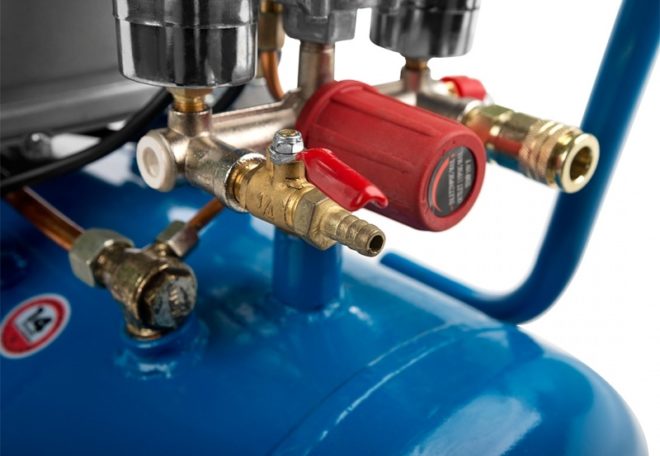
The following reasons can be distinguished that interfere with the normal operation of the engine:
- lack of sufficient pressure to operate the device, poor contact or loose connections. First of all, we check the wire and the plug for a break, with a special screwdriver-voltmeter we check the voltage in the outlet. If the starting capacitors are operational and the voltage is standard 220V, it is necessary to check the fuses and, if they blow, replace them with new ones;
- insufficient pressure in the receiver or violation of the established settings. In this case, all the air is released from the cylinder to check, after which the device is tried to be started again. If the compressor has started, then the relay should be reconfigured, if not, replace the faulty element;
- overheating of the piston group is also a common reason why the device does not turn on. The device should be left alone for 15-20 minutes, after which you can try again;
- incorrect start of the appliance - you must carefully study the operating instructions;
- malfunctions of the piston group - occur due to overload or insufficient oil level.
All these breakdowns are easily fixed, so you should not panic ahead of time. But in the presence of a characteristic smell, one can suspect the worst - the combustion of the compressor engine.
Thermal protection trips or blows out power supply fuse during startup
Causes of failure and methods of elimination:
- The fuse rating is lower than recommended. To avoid tripping in the future, the fuse must be replaced with a more suitable one;
- network congestion - turn off some of the idle devices;
- malfunctions in the relay or bypass valve. Requires professional service;
- overheating caused by high room temperature. It is recommended to move the unit to a cooler, well ventilated area where the compressor will start without problems.
The engine hums, but it does not pump air
A common cause of this phenomenon is an underestimated mains voltage. But, if everything is fine with this, then it is most likely that excessive pressure has formed in the receiver, which provides significant resistance to the piston in the process of pushing air. In such a situation, the device turns off for 15-20 seconds, after which the automatic switch is returned to the “AUTO” position.
If, after such manipulation, the device still does not work, then this indicates a clogged bypass valve. To eliminate the blockage, the cylinder head is removed and the channels are cleaned, after which the compressor will turn on normally. Another cause of the problem may be a malfunction of the receiver relay. In this case, the relays are either changed or they resort to the help of service centers that repair such parts.
Extraneous sounds are heard
As a rule, a variety of knocks, metal rattle and rumble are signs of a malfunction of the piston group. It could be:
- any solid particle entering the cylinder;
- failure of bearings on the crankshaft;
- loosening of the cylinder head bolts;
- cylinder wear;
- wear of bearings or connecting rod bushings;
- piston or ring wear.
The piston system during operation can receive the following defects:
- change in piston or cylinder diameter;
- changing the shape of the cylinder mirror;
- the formation of scratches and scratches on the walls of the cylinders;
- cracks in the working part or flanges.
And if loose bolts only need to be tightened to ensure further normal operation, then worn-out elements require a complex serious repair. In this case, you may have to bore the cylinder and select a new piston. To restore the cylinder, the liners are pressed into it. These processes are quite complex and practically impossible to do at home, since they require special skills and equipment.
Excessive heat
The main factor that contributes to overheating is insufficient oil level, which creates high friction of the working units. If you do not pay attention to the problem, then the compressor will turn off very soon and require serious repairs. Therefore, at the first sign of overheating, it is necessary to check the oil level and, in case of non-compliance with operational requirements, add it.
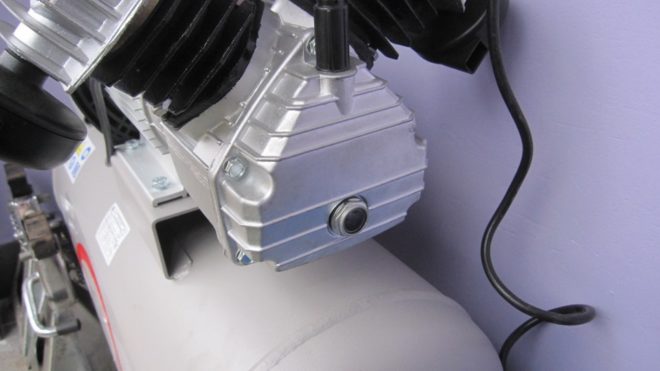
Also, excessive heating can be caused by contamination or weakening of valves, clogged air channels, or foreign objects entering the cylinder airflow. Malfunctions with automation can also lead to such interruptions.
strong vibration
In general, vibration is considered normal for reciprocating compressors, but if it increases over time, then this requires attention. Most likely, the reason lies in the wear of the vibration pads or the loosening of the mounting bolts. You can correct the situation by replacing these elements and carefully tightening the bolts.
High humidity in the intake air
Most often, this phenomenon is associated with contamination of the air intake filter, the accumulation of excess moisture in the receiver, or with high humidity in the room where the air compressor. Correcting the situation is quite simple. For this you need:
- clean or replace the filter;
- regularly drain the accumulated liquid from the cylinder;
- move the device to another, drier, room.
Performance degradation
There are the following reasons for such a malfunction of the device:
- clogged suction filter. To fix the problem, you must remove and clean (or replace with a new one) this element;
- air leak. It is required to carefully examine all hoses and tubes, treating them with soapy water. Leakage can also be associated with wear of the piston rings or the piston and cylinder itself;
- weakening the tension of the belt connecting the crankshaft to the electric motor.
Repair of air compressors is a time-consuming process that requires certain technical knowledge. And if minor problems can be fixed on their own, then with major faults it is best to contact the service center.
A compressor is a device that compresses gas or air. The final pressure created at the outlet is higher than atmospheric and is called the discharge pressure, and the unit itself is called the supercharger. The principle of operation is simple: pistons or screws progressively drive the gas, thus compressing and reducing the volume.
Great option for car painting
The compressor is used in everyday life: , bicycles; when repairing an apartment, pneumatic grinders, hammer, drills.
Superchargers are used in industry: in air cooling systems; in construction; for transport to railway- ensure the operation of the braking system. In the oil refining industry and metalworking, a centrifugal compressor is used - a unit with a radial design, the performance of which far exceeds that of other types of superchargers.
Types of compressors and device
Depending on the compression medium, the following types of compressors are distinguished:
- Gas - the device compresses gas.
- Air.
- Special.
- Circulation - the unit makes it possible to circulate air in a vicious circle.
They are divided depending on the work item into:
- piston;
- screw.
air equipment screw type- enjoys a very high popularity
Consider the compressor device using the example of a screw-type unit. A feature of such a device is the presence of two helical rotors, the rotation of which occurs in opposite directions. During operation, air is in the screw chamber, where it mixes with oil. Then such a mixture is injected with screws into the pneumatic system, then goes to the separator. The subsequent phase - clean air enters the receiver (accumulator) or enters the pneumatic equipment.
Piston is simple in device and according to the principle of operation. It is a metal case with a cylinder inside, which is placed vertically or horizontally.
The forward movement of the piston affects the suction of air, the return movement contributes to compression. At this point, the suction valve is closed, and the discharge valve supplies air to the system. The discharge valve is a check valve for the compressor, as it does not allow the compressed air to expand again and return to the system.
During the operation of the installation, there must be a compressor, otherwise the unit will operate intermittently or turn off completely.
The engine will not start
If the engine does not start, then initially check the presence of voltage. At 220V in the network they change to new fuses, but at the same time they do not install protective components that are supposed to carry a larger current.
Another reason why the electric compressor does not work is the erroneous readings of the pressure control switch. To make sure of this, it is enough to release the gas from the cylinder and start the installation. If the engine was able to start, they reconfigure the corresponding instrumentation or replace them with serviceable ones.
The motor fails when the machine and forces the device to stop. Indeed, the task of the machine is to turn off the power if the piston system is overloaded. In such situations, the appliance is allowed to cool down and switched on again.
Incorrect operation of the thermal protector
With constant operation of thermal protection possible reasons- voltage drop in the network or high ambient temperature. If the room in which the instrument is placed is not ventilated, the piston motor will overheat. It is enough to move the blower to a room where the ventilation problem is solved.
Due to insufficient air supply, the inlet filter is often clogged. Repair of compressors in such a situation consists in flushing or replacing the necessary parts.
Carefully monitor the condition of the air filter
Thermal protection blows the fuse
Sometimes thermal protection turns on directly at start-up, rendering the fuse unusable. Most likely, it does not correspond to the power of the device and must be replaced.
Fuses can blow if the network is overloaded. This is solved by temporarily disconnecting some of the consumers. Repair of air compressors is complicated by improper operation of the voltage relay or bypass valve that has become unusable. It is worth replacing damaged parts with new ones.
The motor runs at low speeds or does not start at all
If the mains voltage drops, the blower motor cannot cope with the axle scrolling. To debug the operation of the engine, it is enough to find out the voltage value (the norm is 220V).
Another reason is an increase in pressure in the receiver. At the same time, the piston does not push air, and the operation of the supercharger is difficult. You just need to put the switch in the "off" position on a short time and turn it on again. If these actions do not change anything, there is a possibility of failure of the pressure control switch directly in the receiver. In addition, the control valve may become clogged.
Why does pressure drop occur in the accumulator
Most likely, the pressure drops due to air leakage. The reason is in the pressure line itself. Repair electric compressor consists of a thorough inspection of the pipeline. To do this, prepare a soap emulsion and coat the joints in the pipeline. If a leak is found, it is treated with sealing tape.
The air outlet cock of the receiver is capable of passing air when it is loose or has become unusable.
The piston head of the compressor is equipped with a control valve, which can also cause the device to malfunction. The cylinder head is disassembled, but air is first released from the accumulator. If this operation does not help, then the valve must be replaced.
An excellent member of the electric compressor family
The air leaving the unit contains a lot of moisture
The gas leaving the compressor may contain excess moisture if:
- water has accumulated in the receiver;
- the air intake filter is clogged;
- The unit is placed in a humid room.
To reduce the effect of air humidity, it is worth regularly:
- drain excess water from the receiver;
- regularly inspect the filter elements;
- it is enough to move the supercharger to another room or change spare parts for the compressor.
Too much engine vibration
A characteristic feature of piston engines is vibration. If its degree is not high, this does not pose a danger to the device. When the unit vibrates strongly, the cause may be worn vibration pads or loose bolts.
Then do-it-yourself compressor repair consists in tightening the bolts until it stops.
Why is the compressor down
The operation of the device may be interrupted for the following reasons:
- The pressure control relay is failing. The worn part is replaced with a new one.
- Strong air extraction due to a mismatch between the performance of the blower and the power input. There can be only one piece of advice: when buying a pneumatic tool for a compressor, first carefully study the instructions.
When purchasing pneumatic tools, be sure to read the instructions for standards, requirements and use.
The blower air flow rate is not commensurate with the norms
This sometimes happens if there is a gas leak or the air intake filter has become unusable. Repair consists in sealing all connections. In this way, air leakage is excluded.
A constant cause of leakage is a loosely closed valve when draining liquid from the receiver, then it remains only to close the valve tightly.
Reed Valve Repair
Spare parts used for reciprocating compressors include reed valves. With a long operation of the supercharger, the edges of the valves become unusable, which causes air leakage. You can try to replace the valves yourself.
Reed valves should be checked once a year.
Compressor piston stuck
Repair of compressor pistons is done independently, for this you need knowledge of some features:
- Foreign objects have entered the cylinder. It is necessary to inspect the piston, replace if necessary.
- The piston pin heats up, which leads to its sticking in the plane. File your finger to get a normal gap. Check the compressor, if necessary, send it to a repair shop.
- The use of low-quality oil for the compressor. It is worth pouring oil according to the instructions.
- Clogged oil line.
Some other compressors and their repair
Now screw compressor units are popular among users. There is almost no friction between the rotors in the devices due to the formation of an oil cushion. This design allows the screws to work for a long time. At the same time, the repair of the screw block of the compressor is practically not required, only the bearings wear out.
If a development appears on the screws, then there is little time left before the block is jammed. Repair screw compressors in such cases is to replace the blocks.
Centrifugal compressors are dynamic devices, they are used to provide air exchange in mines. The main elements of such a unit are a rotor, an impeller with blades and a diffuser or an annular outlet. From the reliability of the lubrication system in a centrifugal compressor. Turbine compressor oil is used to lubricate centrifugal machines.
Repair of centrifugal compressors should be carried out by employees of service centers, as this is complex and expensive equipment.
The scroll compressor is a displacement type blower. It consists of two spiral plates inserted one into the other. Repair scroll compressors it is also better to do the service master because of the complex hermetic design.
The most common air conditioner compressor problems are:
- noises (crack, knock);
- leakage;
- performance loss.
The presence of noise in the supercharger is easily repaired. More often Total extraneous sounds in the device become a sign of problems in the bearing. The item is replaced or repaired. Depressurization is also not a serious problem.
Repairing a car air conditioner compressor is not a difficult task.
WATCH THE VIDEO INSTRUCTIONS
Conclusion
The compressor is easier to maintain immediately after commissioning.
It is easy to avoid errors in operation if you carefully study the instructions for the device:
- Before starting the unit, check the compressor oil and top up if necessary.
- Every 16 hours of operation, drain the moisture from the receiver.
- Every 2 years it is worth inspecting the check valve on the compressor.
- The presence of grounding of non-current-carrying parts is mandatory.
Compliance with such requirements and careful attention to the compressor will reduce the cost of operating the device.
Compressors for painting a car, inflating tires or pneumatic tools need regular inspection, maintenance, and sometimes repair. This is especially true for reciprocating compressors, in which pistons, rings and other parts require frequent replacement. We will talk about the main problems and how to fix them.
The causes of compressor malfunctions can be forced operation, neglect of service periods, design flaws, natural wear and tear of operating equipment. So that the broken unit does not slow down the work, we will try to figure out the reasons for the failure and correct the situation by doing the repairs ourselves.
When the power is turned off, the receiver does not maintain pressure
The decrease in pressure in the receiver when the injection stops indicates that there is a leak somewhere in the system. A soapy solution applied to probable places of leakage will help to detect it:
- compressed air line;
- piston head valve;
- receiver pressure relief valve.
A detected leak through the line can be isolated with tape and sealant. The tap must be screwed all the way and if the soapy solution continues to bubble, then the valve is faulty and needs to be replaced. It is installed using a sealing FUM tape. If both the route and the valve do not show a leak, it can be concluded that the problem is in the piston head valve. To get to it, you need to bleed all the air from the receiver and disassemble the cylinder head. If after cleaning the valve it does not restore its functions, then it will have to be replaced.
Engine does not start
The first thing to check is the mains voltage, the integrity of the connecting cable, and the quality of the contacts. After that, check the fuses and, if necessary, replace them with similar ones. A blown fuse can also occur when it is set with an unreasonably low threshold. In this case, they must be replaced with the appropriate ones for your equipment. If, when installing new fuses, they blow again, look for the cause in a short circuit.
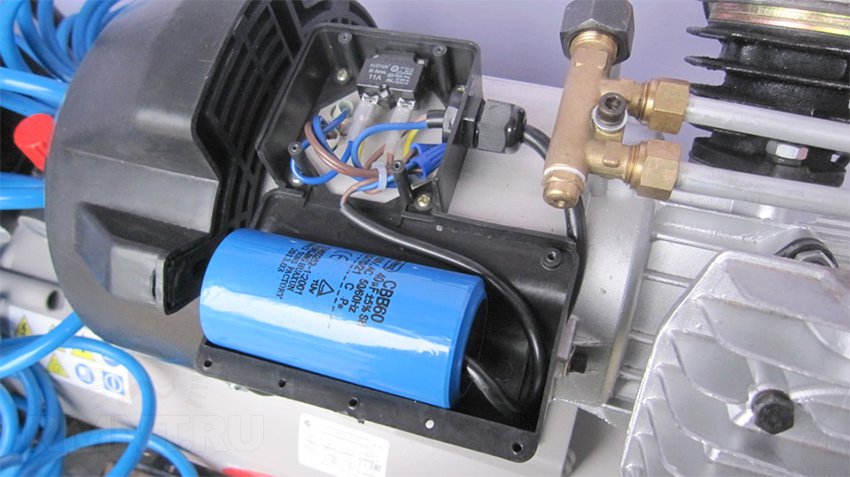
Another reason may lie in the incorrect settings of the pressure switch on the receiver. To test this assumption, you need to bleed the air from the reservoir and try to start the engine again. If it started working, change the settings on the pressure switch.
Sometimes the engine is blocked by an overheat sensor during intensive continuous operation of the compressor. In this case, you need to let the equipment cool down, after which it will work again in standard mode.
No injection occurs
In a situation where the engine is buzzing, but the injection does not occur, the problem may be in the network. If the voltage drops below 220V, the engine may not have enough power to run the compressor correctly. In this case, you can install a stabilizer in the network or, if the phase is overloaded, temporarily disconnect the electrical devices connected to it from the power supply.
If the voltage is not too different from the norm, it is possible that the pressure in the receiver is too high and resists injection. In this case, the masters recommend turning off the compressor for a while and starting it again after 15-20 seconds. If work is not restored, you need to check and, possibly, replace the pressure switch.
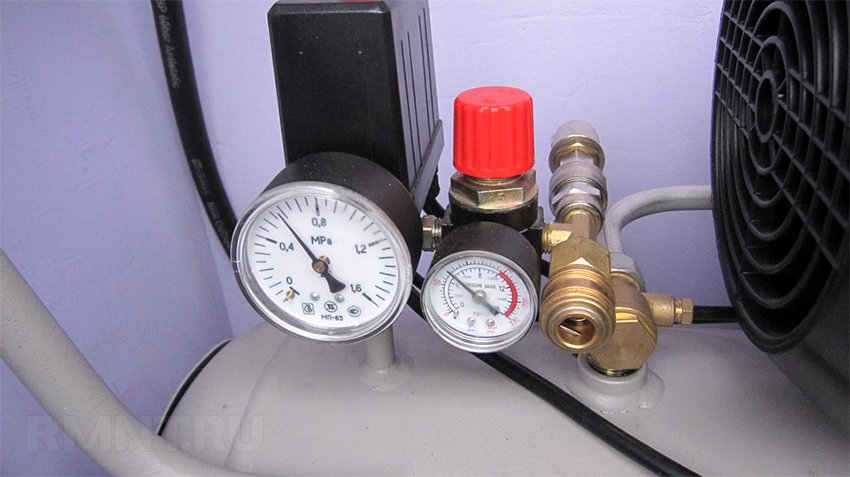 Pressure switch
Pressure switch
Another cause may be a clogged bypass valve, which should relieve high pressure. In this case, you need to remove and clean it. If the valve is damaged, it must be replaced.
In some cases, the cause may be the incorrect operation or malfunction of the voltage relay. It is difficult to fix it yourself, and if it is not possible to contact a service center for repairs, you can replace it.
Unjustified overheating of the unit
The operation of thermal protection automation is understandable in cases where the room temperature is elevated, there is a reduced mains voltage (we check with a multimeter), or the installation works without interruption for a long time.
If everything is in order with the room temperature, voltage and operating mode, then the filter installed at the inlet is clogged atmospheric air. The filter must be cleaned, rinsed, dried and reinstalled. Such manipulations must be performed regularly, with constant work - daily. This reduces the load on the compressor motor, reduces the overall wear of the system.
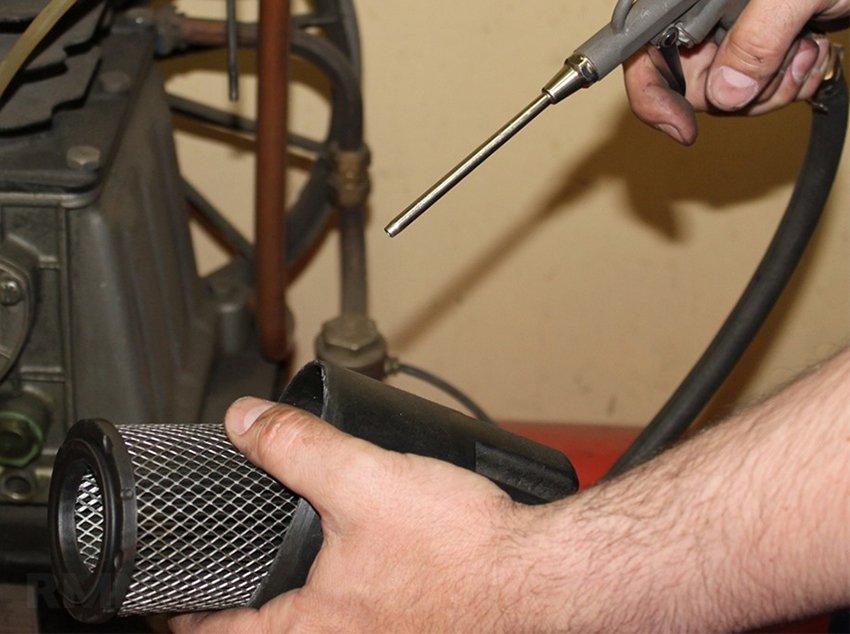
Outlet air contains water particles
In painting work, this situation leads to the marriage of the painted surface. The reasons for its occurrence may be:
- the water from the receiver has not been drained for a long time;
- contamination of the air filter at the inlet;
- high humidity in the workshop.
The problem is solved depending on the cause. Accumulating water must be regularly removed from the receiver using the drain valve. The supply filter is cleaned or replaced. High humidity in the room can be dealt with by ventilation equipment or by installing additional dehumidifiers.
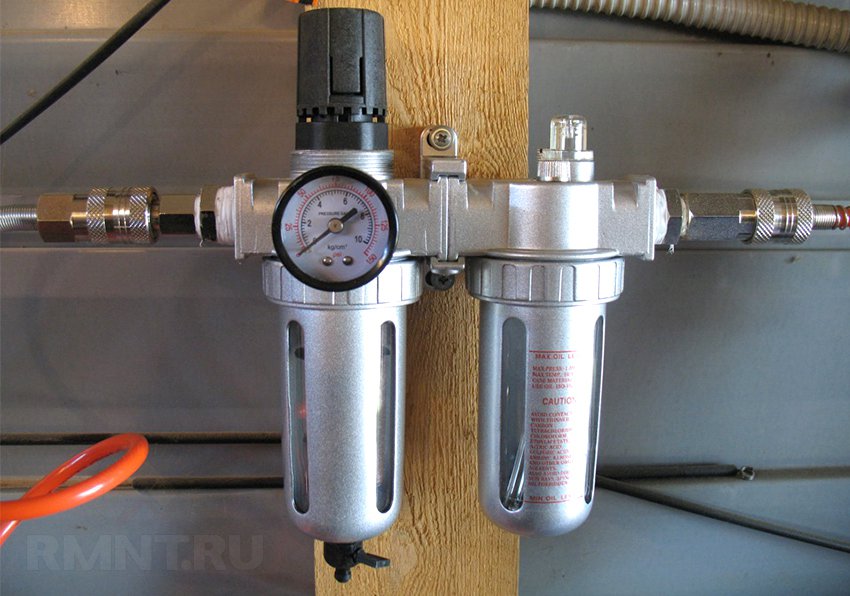 Filter drier
Filter drier
Repair of the crank mechanism of an automobile compressor
If the crank mechanism fails, it must be disassembled and the loose crank hole repaired. To do this, cut new thread taking into account that the motor shaft rotates counterclockwise.
Compressor head overheating, oil leaks
Possible causes of the problem are:
- piston ring defects;
- oil contamination;
- hauling connecting rod bolts;
- insufficient clearance at the joints of the piston rings;
- loose studs.
If oil leaks, a worn oil seal may need to be replaced. It may also be time to clean or replace the oil filter, replace the retaining ring. To do this, the compressor will have to be disassembled.
Removing the front cover of the compressor
It is necessary to unscrew the mounting bolts on the front cover of the compressor and use a reverse hammer to remove the guide pins. After that, screw in the guide pins and push the front cover of the compressor onto them.
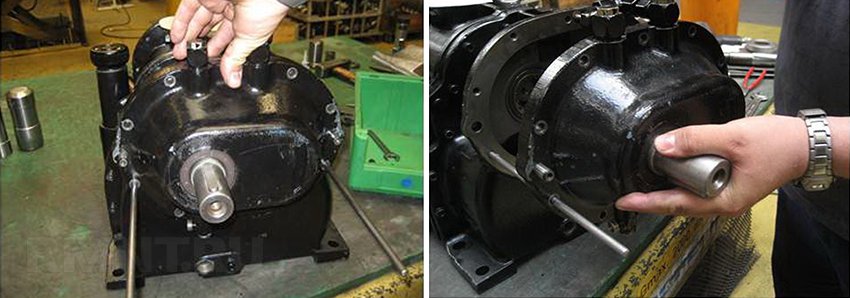
To remove the front cover, you need an open-end wrench unscrew the oil supply pipe.
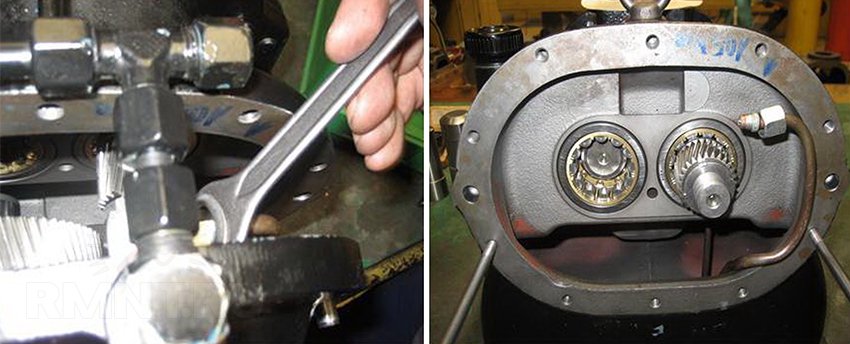
Removing the oil pump
From the front cover you need to unscrew and remove the gear oil pump by gaining access to the bearing and pulling it out by hand.
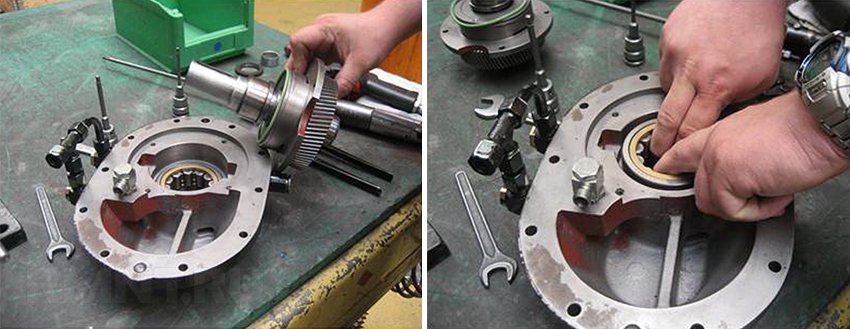
After that, it is necessary to carefully remove the retaining ring and knock out the stuffing box.
To remove the locking sleeves, you need to warm up the installation site over an electric stove. Due to the different thermal expansion, the bushings will be removed more easily.
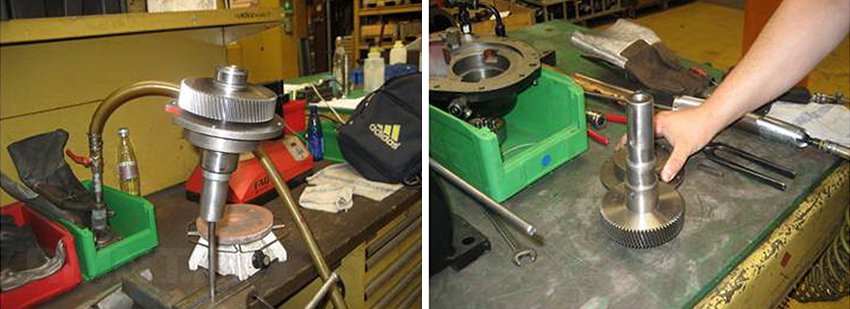
After that, it is necessary to remove the oil pump and remove and replace the oil filter.
![]()
To check the quality of the oil, you need to remove the back cover of the compressor and check whether clean oil is supplied to the gears through the oil supply hole. The oil must be free of foreign matter.

Oil pump assembly, oil seal installation
Let's start assembling the oil pump. At the first stage, we collect the sleeve.
After that, you need to install the bearing and sleeve in the socket. We install the pump.
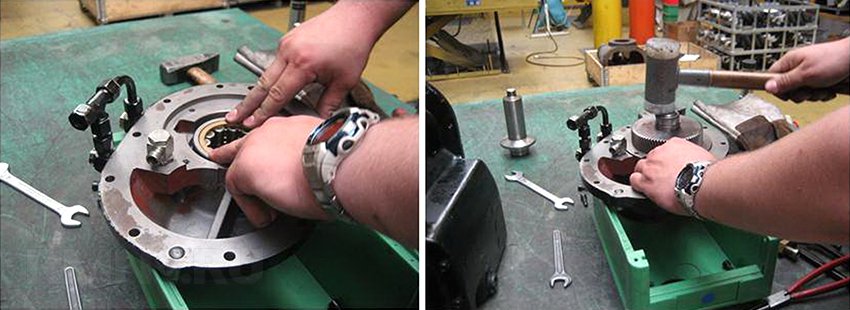
To install the gland, you will need mandrels. Masters recommend the use of anaerobic adhesive-fixative. Check the seal for integrity, no burrs or other damage. Clean the installation site with a clean, lint-free cloth. Install the protective ring with the stuffing box and the mandrel for pressing the stuffing box. Slide the gland into the seat. Remove the protective ring and mandrel. Install a new retaining ring.
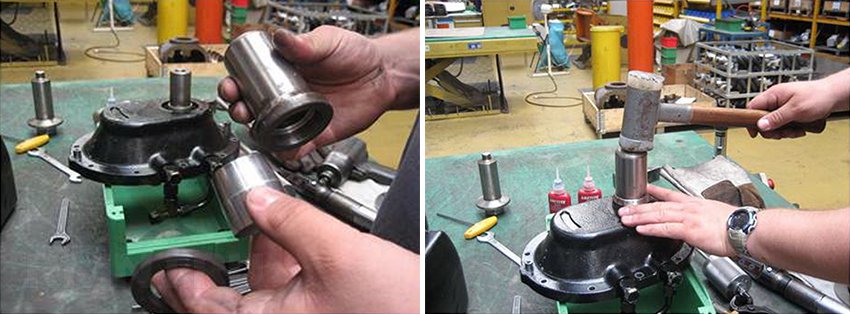
Oil filter replacement and compressor assembly
To install the front cover, you need to set the guide pins and push the cover. Screw on the oil supply pipe and seat the cover bolts on the adhesive sealant.

In conclusion of the review of repairs, we suggest that you watch a video about compressor repair.
A little about service
In order for the equipment to work as it is supposed to, it is necessary to perform periodic maintenance. So, it is recommended to change the oil every 500 hours of operation, but at least once a year, provided that a high-quality and recommended brand is used. V homemade compressors you can not solder the oil filling tube, this will facilitate its replacement in the future. Check the oil level, it may leak and burn out. As it gets dirty, it is necessary to dismantle and clean the protective grille. Periodically check the grounding to avoid accident and damage to the equipment.
The valves should also be inspected periodically - cleaned with a solvent and polished if necessary.
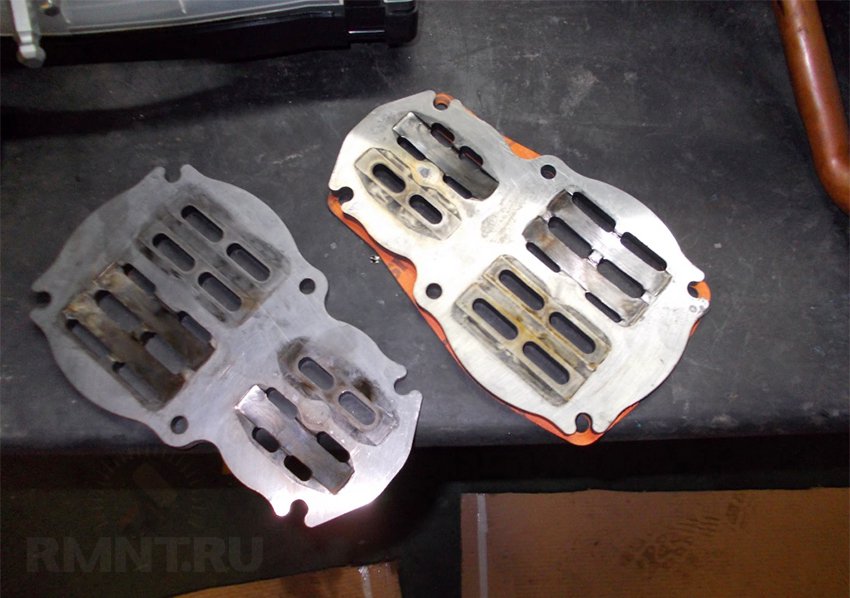
Drain the water from the receiver regularly, clean safety valve and inlet air filter. This will protect your compressor from premature wear. Performing these manipulations daily, you yourself will be able to establish the optimal regularity of these actions for your conditions and scope of work. If the compressor has been idle for a long time, it is recommended to clean and lubricate the parts before starting. The implementation of these preventive measures will prevent or delay the breakdown and repair of the unit, and extend its service life.
The screw compressor belongs to one of the most efficient types of equipment, thanks to which compressed air is obtained in various industries (engineering, electronics, woodworking, pharmaceuticals, furniture). The features of the operation of compressors, possible malfunctions and methods for repairing equipment will be discussed in our article.
Components of equipment
Screw equipment consists of the following main elements:
- Corps. In most cases, it is made of steel, which is coated with a non-combustible, noise-absorbing and oil-resistant material.
- The screw block of the compressor (it is also called a screw pair), which is the "heart" of the equipment. It consists of two high-tech rotors, which are located in the inner part of the body.
- Three types of pipelines: oil, air and air-oil.
- suction valve. Regulates the performance of the unit by pneumatic control.
- Suction air filter. Designed to clean the air that enters the compressor. In fact, it consists of two filters that are installed in front of the suction valve and on the unit body (where air is taken in).
- Belt drive. Provides a certain speed of rotation of the rotors (the higher it is, the better the performance of the equipment) by combining the "efforts" of the two pulleys located on the screw pair and the engine. Powerful compressors equipped with a gearbox or a direct drive clutch.
- Electric motor. Through a belt drive, it drives a screw pair.
- Fan. Promotes air flow and cooling of the screw pair and the electric motor.
- thermostat. This element in the screw compressor circuit plays the role of a regulator temperature regime. Thanks to the thermostat, oil with a temperature above 72ºС passes through the cooling radiator.
- Oil filter. Cleans the oil before entering the screw pair.
- Oil separator. metal tank, in the middle part of which there is a partition with holes. The process of cleaning the air from oil occurs by creating centrifugal force.
- Oil cooler. Cools the oil after separation from the compressed air.
- End air cooler. It cools the compressed air before it is supplied to the consumer, and at the outlet of the equipment it makes the temperature exceeding the ambient air temperature by 10-15ºС.
- Blok electronic control. Controls the operation of the screw compressor and displays the operating data of the equipment.
- Pressure switch. Sets the maximum compressor pressure. The latest models of equipment do not have a relay, because an electronic control system is used.
- Safety valve. When the pressure in the oil separator exceeds the maximum possible value, it is automatically triggered.
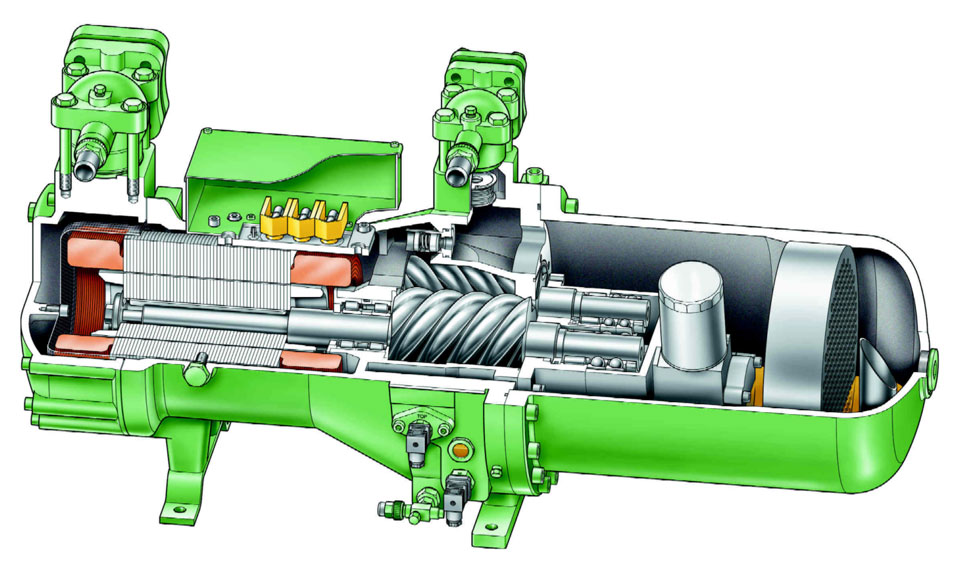
Advantages and working principle
The huge demand for screw compressors is due to the fact that they have numerous advantages compared to using centrifugal or reciprocating equipment. The main ones are:
- ease of installation and connection;
- continuity of work;
- maximum reliability;
- long operating period;
- the presence of small operating costs;
- obtaining almost ideal air purity;
- minimum energy consumption per 1 m³ of air;
- low noise figure;
- availability of an automatic control system.
Based on the device of the screw compressor, its principle of operation is as follows:
- when passing by the suction valve and air filter, air flows into the screw block;
- air is mixed with oil, which circulates in a closed space;
- through the action of the screw block, the mixture of oil and air enters the oil separator;
- the air is separated from the oil and directed to the compressor outlet;
- oil in a small or large circle through the oil cooler (depending on the temperature of the material) returns to the screw block;
- the screw block is started using an electric motor;
- automatic shutdown (or inclusion) is performed using a pressure switch.
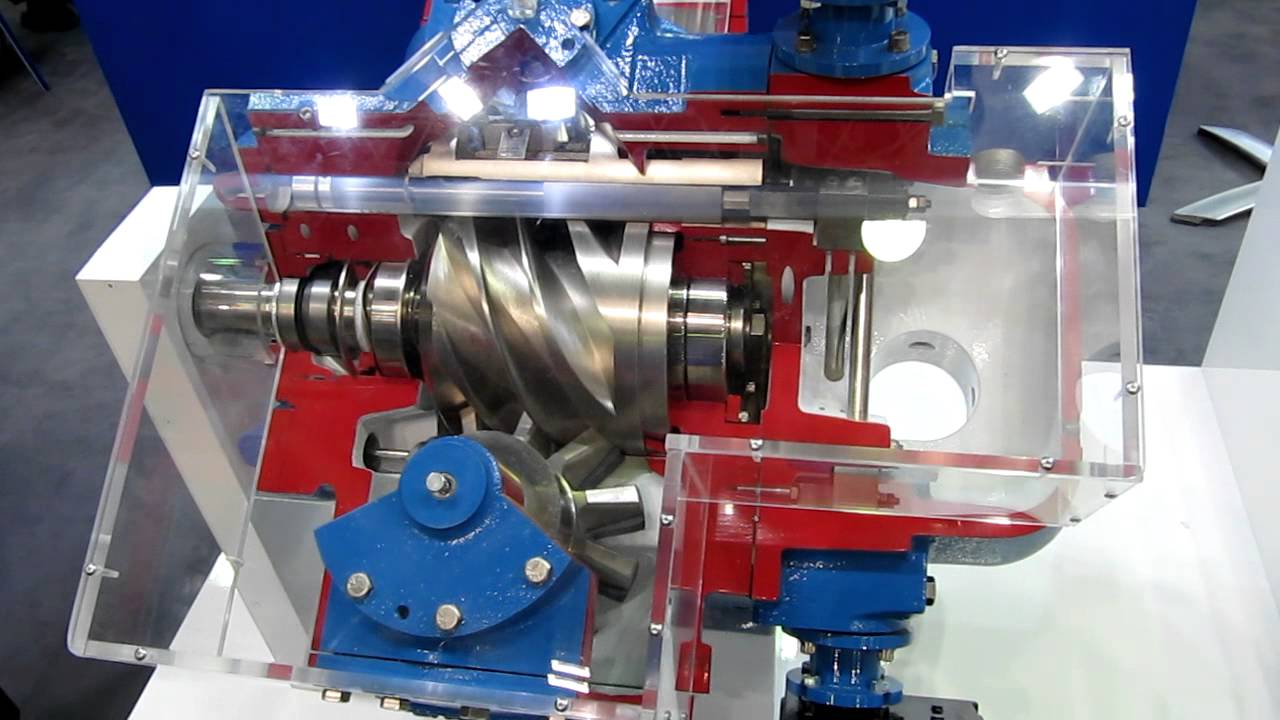
It should be noted that oil in screw equipment performs several functions:
- creates an oil film;
- removes heat;
- distributes air currents;
- provides a gap between the rotors of the screw block;
- lubricates the bearings of the working elements.
Causes of malfunctions and solutions
During the operation of the equipment, you may encounter a breakdown. We have to resort to the repair of screw compressors. The most common hardware failures include:
- the compressor turns on poorly or does not restart;
- the unit does not receive compressed air;
- low equipment performance;
- excessive consumption and oil leakage;
- involuntary opening of the safety valve;
- shutdown of the compressor by the thermostat;
- high blood pressure;
- circuit breaker operation.
The compressor does not start well, does not restart, does not receive compressed air, is characterized by poor performance
The main reason for poor start-up of the equipment is too low air temperature. You just need to warm up the room in which the compressor is located, and everything will be in order.
The unit does not restart due to poor closing of the suction valve. It needs to be removed and cleaned. In some cases, elements will need to be replaced.
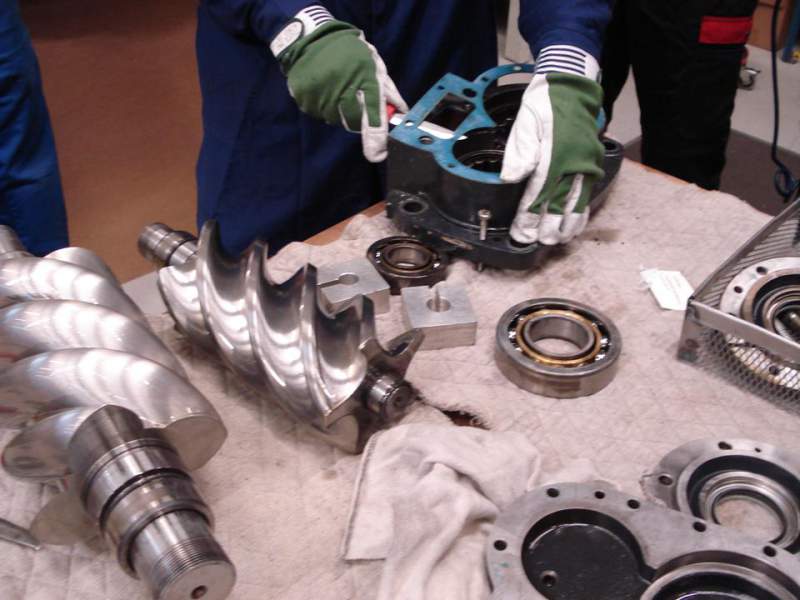
The absence of compressed air at the compressor outlet indicates that the regulator is closed. You can fix the problem by checking the pressure switch, which should supply power to solenoid valve associated with the controller.
In most cases, the low performance of the unit is also associated with the closure of the regulator. But in this case, the cause of the malfunction is contamination of the regulator. To eliminate this, the suction filter is removed, the regulator is opened and cleaned. Best Option- dismantling the regulator with its subsequent cleaning.
Excessive consumption and oil leakage
The reasons for too much oil consumption can be:
- broken oil separator filter;
- Leaky oil separator filter seals.
In both cases, problems are solved by replacing the seals or the filter itself.
An oil leak from the suction filter indicates that the regulator is not closed or the pressure in the system is excessively high. In the first case, the functioning of the regulator and the solenoid valve is checked. In the second case, in addition to checking the regulator and valve, you should carefully examine the pressure gauge.
The cause of oil entering the control panel is oil leakage through the flange of the unit. This problem is corrected by replacing the compressor O-ring.
Relief valve opening, high pressure, thermostat and circuit breaker tripped
The reason for the opening of the safety valve may be a clogged oil separator filter. Check the pressure drop between the oil separator tank and the compressed air line. If necessary, the filter should be replaced.
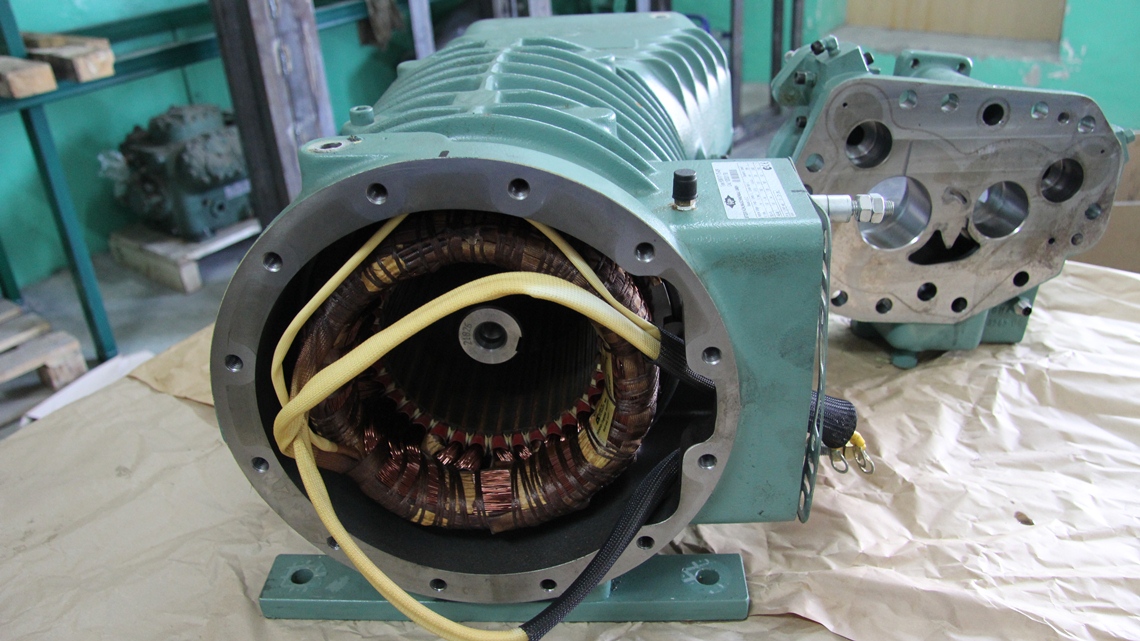
If there is a pressure that exceeds the maximum set value, the regulator must be checked. There may be no command to close it. Make sure the solenoid valve is off.
The compressor is switched off by the thermostat if:
- thermal expansion valve malfunctions;
- insufficient amount of oil;
- drainage system failure.
These problems are solved accordingly as follows:
- the valve is being replaced;
- oil is added to the desired level;
- the check valve and pipelines draining the oil are checked.
Circuit breaker operation is associated with:
- overheating of the electric motor;
- insufficient voltage in the network;
- excessively high room temperature.
When the motor overheats, the relay and the heat sink from it are checked. With normal heat dissipation, the reset button is pressed and the compressor restarts.
The same actions are performed in the presence of insufficient voltage in the network and high room temperature. The only difference is the preliminary voltage check and the provision of high-quality ventilation, respectively.
Screw Compressor Troubleshooting Video:
Compressor/unit does not work (does not start)
| Power switch does not work |
|
| Compressor |
|
| High and low pressure switch |
|
|
In all compressors, the main and starting windings are arranged as shown in the figure to the right. The resistance values are specified by the compressor manufacturer in the relevant technical literature.
As a rule, all compressor motors have a built-in protection device.
If this device shuts down the engine due to an increase in engine temperature caused by heat buildup, the shutdown period can be quite long (up to 45 minutes). If the motor does not work after that, it is necessary to carry out a resistance measurement, which should determine whether the protection device did not work or the motor winding is faulty. Compressor mechanical jamming will manifest itself after repeated attempts to start the engine, accompanied by high current consumption and high winding temperatures, which will lead to the operation of the protection device.
The fact that a compressor is overloaded can be determined by the failure of the compressor to turn on, or by turning it on and then turning off after a short period of operation (due to the operation of a protection device). If the compressor is operated outside its application range, the natural result of its operation will be to overload the motor. Compressor application limits, such as permissible voltages, frequencies, as well as the type of refrigerant, are given in the relevant technical documents.
In systems that do not have a high pressure safety switch on the discharge side, the compressor may be overloaded by a faulty or tripped fan motor due to its own safety device. In general, the amount of refrigerant in the system must be accurately determined. In capillary tube systems, the most commonly used method for determining sufficient charge is to measure the temperature of the refrigerant in and on the suction line.
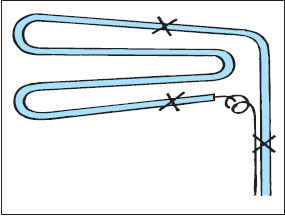
In systems with charge volume must be monitored using a sight glass. In both cases, the volume of refrigerant in the system must be less than the free volume of the lines on the discharge side.
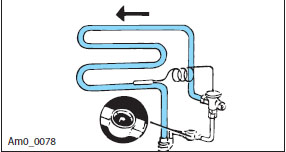
Compressors designed for capillary systems are usually equipped with a PTC LST (low starting torque) starter. Before each start-up of a compressor with a PTC device, the pressures on the discharge and suction sides must be equalized. In addition, in order for the compressor to start, the device must be kept de-energized for about 5 minutes, so that it cools down sufficiently and can provide maximum starting torque.
In the event that a "cold" compressor is started and the current is cut off after a while, there may be a conflict between the PTC starter and the motor protection device. Because the engine remains warm, it may take about 1 hour for the compressor to start normally.
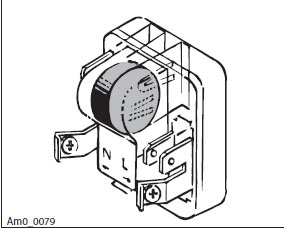
In systems where pressure equalization is not necessary before starting, the compressor must be equipped with an HST (High Starting Torque) starter. It can also work in systems with and requires some cooling time, which in general takes no more than 5 minutes. Faulty or misconfigured relays and starters can also cause many compressor start problems and cause the compressor to shut down via the motor protector.
Pay attention to the technical data provided by the compressor manufacturers. If you suspect the starter is defective, replace all hardware, including the relay and start capacitor.
The PTC device (25 ohms for mains voltage 220 V and 5 ohms for voltage 115 V) can be checked with an ohmmeter. The start relay can be tested with a lamp. The relay is OK if the lamp does not light up when the relay is upright and lights up when the relay is reversed.
Danfoss manufactures condensing units with a two-piece high and low pressure switch that protect the compressor from too high pressure on the discharge side and too low pressure on the suction side. If the compressor is switched off by the high pressure switch, it is necessary to check whether the pressure surge has actually occurred. If the compressor shuts down on a low pressure switch signal, the reason for this may be insufficient refrigerant in the system, a leak in the system, evaporator icing and / or partial blockage of the throttle device. If no pressure deviation is noted on the high and low pressure sides, it is necessary to check the health of the relay itself.
The unit can also shut down due to a faulty or incorrectly set/selected temperature switch (thermostat, temperature controller).
If the temperature controller has lost charge or if the temperature setpoint is too high, the compressor will not start. If the temperature differential of the controller is too small, the compressor off period will be too short and when using an LST starter, it will be difficult to turn it on. If an HST starter is used, this may shorten the life of the compressor.
The optimum pressure equalization time when using the LST starter is 5-8 minutes for refrigeration units and 7-10 minutes for freezers.
When using the HST starter, the compressor hourly periods should be set as short as possible. Under no circumstances should there be more than 10 switchings per hour. Refer to the Installer's Manual, section "Temperature Switches" for tips on setting up temperature controllers and troubleshooting.











Chicken in kefir - recipes for marinated, stewed and baked poultry for every taste!
Simple Chicken Recipe in English (Fried) Recipes in English with translation
Chicken hearts with potatoes: cooking recipes How to cook delicious chicken hearts with potatoes
Recipes for dough and fillings for jellied pies with mushrooms
Stuffed eggplant with chicken and mushrooms baked in the oven with cheese crust Cooking eggplant stuffed with chicken